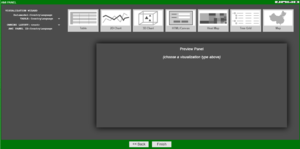Introduction to AMI
An Introduction to AMI
Overview
The AMI platform is a comprehensive suite of components designed to provide a consolidated view across all the various applications and IT resources within large information technology environments. It has interfaces and adapters for interacting with the most expansive technology environments.
Architecture
The AMI architecture is designed for easy installation with the ability to easily scale as needed. For getting started with lower capacity needs, AMI can be installed and run as a single process. For additional capacity, AMI supports vertical scaling such that the interaction with front end and backend applications can be broken out into separate processes. Beyond that, even more capacity can be achieved through horizontally scaling additional AMI processes.
Single Process
AMI will scale as the processing needs scale. For use cases where all processing can be done through a single instance, only a single AMI One process is necessary. This process contains all the components and interfaces discussed above. The architecture is quite simple:
NOTE: AMI One simply bundles all the functionality of the AMI Relay, AMI Center and AMI Web in a single process (the Relay, Center and Web are discussed later in this document).
Vertical Scaling
Vertical and Horizontal Scaling
AMI Relay Diagram
AMI Center Diagram
AMI Web Diagram
Components
AMI has 5 key components:
- Webserver - AMI's self-contained webserver is used for hosting the dashboard builder tool as well as the dashboards themselves. The webserver is specially designed for supporting real-time AJAX enabling fast and efficient data visualization and interaction.
- In-Memory Database - The in-memory relational database stores system configurations and custom data. It is a full-featured SQL-based database with specialized features for data analysis, machine learning and event processing. All data is accessible from dashboards in real-time - meaning that changes to the data can be viewed in real-time from the front-end without refreshing or re-running queries. External applications can also use the JDBC interface for querying and mutating the database.
- Event Processing System - AMI supports real-time high-speed streaming of data into its core in-memory database. As data streams in, it can be processed by filters, triggers, timed jobs and more. The resulting data can be viewed in real-time through the dashboard. Additional events can be generated when event sequences are processed accordingly.
- Data Virtualization - Any number of databases, remote file systems and custom processes can be passively attached to AMI. These attached "datasources" can then be queried by AMI. Queries are invoked either via the event processing system, scheduled timers and/or user solicited actions such as mouse clicking on a row or button. Queries can be executed across multiple datasources simultaneously with results being blended. This virtualization layer can also be used to upload data.
- Plugin Management - AMI supports a variety of plugins at various touch points throughout the platform. Plugins are loaded into the JVM at startup by referencing the plugins' class names in the appropriate properties.
- test image -
3forge Release Management
File Naming
The AMI software is downloaded from our 3forge.com portal and installed locally. The binary downloads are named with the following syntax:
ami_os_relnum_branch.file_extension
Example: ami_unix_12103_stable.sh indicates that it's a release for the unix operating system with a release number of 12103 in the stable branch.
os: Operating system, either windows-x64, unix or macOS
relnum: An incrementing release number
branch: Indicates the level of testing and maturity
Note: the relnum + branch is considered the version
